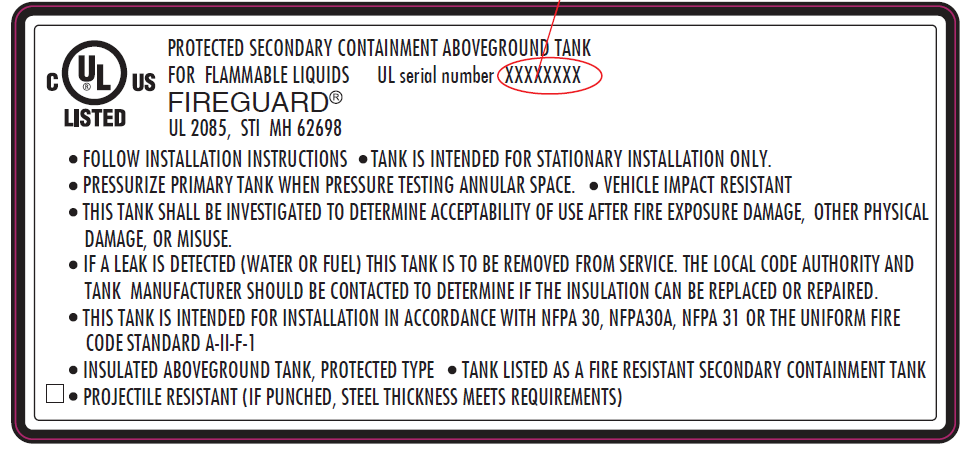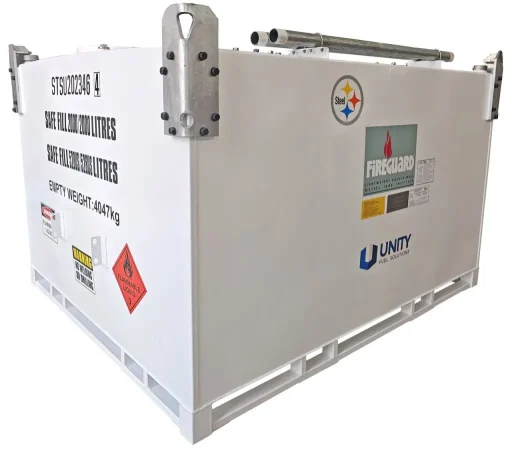UL 2085 – The Industry Standard for Fire-Protected Fuel Storage

If your business uses a lot of fuel for daily operations, it probably has aboveground fuel storage tanks, too. That means the people making decisions likely know about the UL 142 standard, but have they heard of UL 2085? It’s another tank standard that can bring practical benefits to your daily operations, specifically how and where you set up your fuel storage tanks. Let’s take a deeper look at UL 2085.
It’s easy to feel confused when it comes to standards because fuel storage tanks can comply with more than one standard. Often, compliance with several standards is required. The good news is we can break down UL 2085 into something easy to understand. Then, you’ll find it easy to compare standards, like UL 142 vs UL 2085, and be able to ensure environmental responsibility and workplace safety.
What is UL 2085 Standard?
UL 2085 is a safety standard developed by UL Solutions for “Protected Aboveground Tanks for Flammable and Combustible Liquids,” such as gasoline, diesel, biodiesel and ethanol. Compliance with UL 2085 limits the heat transferred to the primary tank during a fire and protects the tank from physical damage.
The “UL” in UL 2085 stands for UL Standards & Engagement, one of the three arms of the 129-year-old testing, inspection and certification organization previously known as Underwriters Laboratories. Today, it’s simply known as UL. The organization ensures consumer product safety in more than 110 countries.
(UL certification isn’t limited to products. UL certifies personnel, facilities, processes and systems to applicable standards and requirements. When a product is “UL LISTED,” it has undergone rigorous UL testing and complies with UL standards.)
The “2085” in UL 2085 designates which standard. Since UL published its first standard for tin-clad fire doors in 1903, the nonprofit has published 1,700 safety standards.
Unlike basic steel tanks (which only must meet the less stringent UL 142 standards), UL 2085 tanks are more rugged with optional testing for additional protection against vehicle crashes and bullets. These tanks must pass resistance tests that simulate real emergencies and will be marked accordingly.
Tanks that comply with UL 2085 also are known by the more common term Fireguard® Tanks.
The trademark “FIREGUARD” for UL 2085 aboveground storage tanks belongs to the Steel Tank Institute/ Steel Plate Fabricators Association (STI/SPFA). Companies that manufacture FIREGUARD tanks do so under license from STI/SPFA. Fireguard tanks meet the UL 2085 standard for ballistics and impact protection and use a lightweight thermal insulation material that exceeds the UL 2‐hour fire test.
Fireguard tanks comply with UL 2085 and UL 142.
What Are UL 2085 Requirements?
Performance tests
UL 2085 requires tanks to have more features and tests that provide added layers of protection:
- Fire resistant for at least two hours. UL 2085 tanks must withstand direct flame exposure for two hours without structural failure.
- Thermally insulated. UL 2085 tanks must have double walled construction plus insulation that protects the fuel.
- Secondary containment. UL 2085 must include secondary containment to protect soil and groundwater against contamination from leaks and spills.
- Protected against vehicle impact. UL 2085 tanks marked to protect against vehicle impact must be tested to survive a 12,000-pound vehicle hitting the tank at 10 mph.
- Bullet resistant. UL 2085 tanks marked to resist penetration from small arms fire must survive testing.
UL 2085 tanks are “tougher” with added protection for fire and ballistics, but they must comply with UL 142, which covers steel tank construction, performance tests, markings and production line tests, and manufacturing and production tests.
There’s an easy way to remember which standard is more specific. UL 2085, which has a bigger number than UL 142, has the bigger requirements.
(Stay tuned for our upcoming in-depth article comparing UL 2085 vs. UL 142.)
Markings and production line tests
Tanks must include specific markings (see bullets below).
- Each aboveground tank that complies with UL 2085 requirements must have a permanently affixed UL Listing Mark.
- The Listing Mark includes the UL symbol, the word “LISTED,” a control number and the name of the tank construction indicated in the manufacturer’s Listings (e.g., Secondary Containment Aboveground Tank, Generator Base Tank, etc.)
Other Certifications
UL 2085 certified tanks may have other certifications attached to them. A widely accepted standard is the “FIREGUARD®” certification, stamp and trademark which belongs to the Steel Tank Institute/ Steel Plate Fabricators Association (STI/SPFA). While many companies manufacture FIREGUARD® tanks, they do so under license from STI/SPFA and in accordance with the UL 2085 standard.
UL 2085 Compliance Plates


UL 2085 tanks must also comply with UL 142 so you should see a UL 142 compliance plate on the tank as well.

What’s Not Covered
UL 2085 does not cover external third-party equipment or components that are shipped with, attached to or added to tanks. Examples of what’s not covered include hoses, pumps, meters and fuel management systems installed as third-party items to help operate fuel dispensing facilities, motor fuel dispensing at farms and isolated construction sites, and on-demand mobile fueling as quoted in NFPA 30A.
It is expected that the authority having jurisdiction (AHJ) — generally a local fire or building inspector — will approve the use and/or installation of these fire-rated accessories independent of the tank Listing.
Consult your AHJ about specific code requirements outside the scope of UL 2085.
Reasons for UL 2085 Tanks
Many business owners wonder if upgrading to UL 2085 tanks makes good financial sense or if their UL 142 tanks are sufficient. The decision depends on each company’s situation, location, budget, daily operations, risk tolerance and authority having jurisdiction (AHJ). Check with your AHJ about compliance with safety codes such as NFPA 30, NFPA 30A and the International Fire Code.
In our experience, the main reason business owners install UL 2085 fuel storage tanks on-site is to reduce separation distances between storage tanks and buildings, boundaries or fixed sources of ignition. Installing a UL 2085 tank allows you to safely place fuel storage and pumping facilities next to key infrastructure, enabling cost savings and improving operations.
For example, The City of Ramsey Fire Prevention Bureau allows UL 2085 aboveground storage tanks with capacities of less than 6,000 gallons to be located 5 feet from the public way, property line or a building. For non-UL 2085 compliant aboveground storage tanks, the minimum allowable distance is 50 feet.
The reduction in separation distances depends on stored fuel volume and the local AHJ’s fire code. Be sure to consult your AHJ at all stages.
Other industry data can provide valuable insight, too.
- Fire risk. U.S. businesses spend more than $13 billion annually on fire loss incidents, according to the National Fire Protection Association (NFPA). With a UL 2085 tank, associated fire risk plummets.
- Environmental concerns. Americans care about clean soil and water, and they like to do business with organizations that share their concerns. Double-wall construction and spill containment help meet federal and state Environmental Protection Agency requirements.
- Less worry. Aboveground tanks are faster to install and have lower maintenance costs than underground tanks. UL 2085 tanks provide extra safety and peace of mind.
- Lower insurance premiums. Check with your insurance agent. Some properties with fire-rated tanks reap lower insurance premiums because of the reduced fire risk that comes with UL 2085 tanks.
Unity UL 2085 Fuel Tanks
Unity Fuel Solutions makes 27 types of UL 2085 LISTED tanks in safe fill volumes from 264 to 16,326 gallons and 2-hour and 4-hour fire ratings:
Unity FGC UL 2085 Fuel Tanks
Unity FIREGUARD® FGC tanks are smaller UL 2085 double walled fuel storage and management solutions for gasoline, diesel, lubricants and other hydrocarbon liquids.
- Capacity: 264 to 2,642 gallons
- Safety: Double-walled tank = SFL primary tank + fire-resistant interstitial space + secondary external tank. Designed as integral secondary containment. Do not require independent bunds for leak containment.
- Convenience: Reduces minimum separation distances and offers a greater range of practical solutions. Cuts costs on transport, installation and relocation.
- Compliance: UL 2085, UL 142, ULC-655, SwRI

Unity FGT UL 2085 Fuel Tanks
Unity FIREGUARD® FGT tanks are larger UL 2085 double walled fuel storage and management solutions for gasoline, diesel, lubricants and other hydrocarbon liquids.
- Capacity: 1,823 to 16,326 gallons
- Safety: Double-walled tank = SFL primary tank + fire-resistant interstitial space + secondary external tank. Designed as integral secondary containment. Do not require independent bunds for leak containment.
- Convenience: Reduces minimum separation distances and offers a greater range of practical solutions. Cuts costs on transport, installation and relocation.
- Compliance: UL 2085, UL 142, ULC S655, SwRI

More Resources
Need Help? Ask the Experts
For help in choosing the right UL 2085 tank, it makes sense to ask the experts. Unity Fuel Solutions is North America’s leader in double walled storage tanks. For advice on the tank and system that’s right for you, call the Unity team at 800-234-1689.
